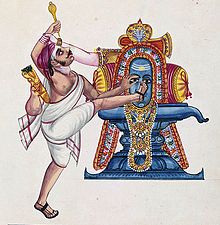Kannappa
This article includes a list of general references, but it remains largely unverified because it lacks sufficient corresponding inline citations. (April 2017) |
This article needs attention from an expert in Hinduism. (October 2020) |
Kannappar | |
|---|---|
 Kannappar Nayanar | |
| Born | Dinna Vyadha Unknown Uduppura, Bharatavarsha |
| Known for | Nayanmar |
Kannappa was a staunch devotee of Shiva and is closely associated with Srikalahasteeswara Temple.[1][2] He was a hunter and is believed to have plucked his eyes to offer to Srikalahasteeswara linga, the presiding deity of Srikalahasti Temple.[1][2] He is also considered one of the 63 Nayanars or holy Saivite saints, the staunch devotees of Shiva. According to historical chronicles, he was Arjuna of the Pandavas in his past life.
Birth and Life[]
Kannappa Nayanar is a South Indian saint also known as Thinnappan, Dinna, Kannappa, Tinnappan, Dheera, Bhakta Kannappa, Thinnan, Kannappan, Dinnayya, Kannayya, Kannappa Nayanar or Nayanmar, Kannan, Bhakta Kannappan and Dheeran. He was born in a vyadha (hunter) family, the son of Raja Naga Vyadha and his wife in Uduppura (modern Vutukuru) near Sri Kalahasti, in present-day Utukkuru, Rajampet Andhra Pradesh. He is an ancestor of the modern-day community.[citation needed] His father was a notable gerent among their hunting community and a great Shaiva devotee of Sri Kartikeya. He was named Dinna or Dheera by his parents, which is known to Tamil-speakers today as Thinnan or Dheeran respectively.[citation needed] His wife's name was Neela.
History[]

When Arjuna was meditating on Lord Shiva for Pashupatastra, to test him, Shiva entered that forest as an animal hunter and due to two arrows from Shiva and Arjuna killing a demon named Mooka, a war started between Shiva and Arjuna, a battle took place between both and finally impressed by Arjuna's efforts, Shiva gave him the Pashupatastra. However, because of his boastful nature of being the greatest warrior, he is born again as a devotee in the Kali Yuga as Kannappa Nayanar and finally got liberation.
Kannapa was born as Thinna and was a staunch devotee of the Vayu Linga of the Srikalahasteeshwara Temple which he found in the forest while hunting. Being a hunter, he did not know how to properly worship Lord Shiva. It is said that he poured water from his mouth on the Shiva lingam which he brought from the nearby river Swarnamukhi. He also offered Lord Shiva whatever animal he hunted, including swine flesh. But Lord Shiva accepted his offerings since Thinna was pure at heart and his devotion was true. Once, Lord Shiva tested the unshakable devotion of Thinna. With his divine power, He created a tremor and the roof-tops of the temple began to fall. All the priests ran away from the scene except for Thinna who covered the linga with his body to prevent it from any damage. Hence he was named thereafter as Dheera (valiant one).
Thinna noticed that one of the eyes of the Shiva linga was oozing blood and tears. Sensing that Lord Shiva's eye had been injured, Thinna proceeded to pluck his one eye out with one of his arrows and placed it in the spot of the bleeding eye of the Shiva linga. This stopped the bleeding in that eye of the linga. But to complicate matters further, he noticed that the other eye of the linga has also started oozing blood. So Thinna thought that if he were to pluck his other eye too, he would become blind to exactly know the spot where he has to place his own second eye over the bleeding second eye of the lingam. So he placed his great toe on the linga to mark the spot of the bleeding second eye and proceeded to pluck out his other and only eye. Moved by his extreme devotion, Lord Shiva appeared before Thinna, stopped him from plucking his only eye and restored both his eyes. He made Thinna the 10th of the 63 Nayanars and he was called as Kannappan or Kannappa Nayanar. Kannappa merged into the linga along with Lord Shiva and Kannappa, who was Arjuna in his past life, got moksha (liberation) at last.
See also[]
- Kalahasti Temple
- Bedara Kannappa
- Bhakta Kannappa
Bibliography[]
- Bai, Lilli. Kannappa Nayanar Puranam. (in Tamil) 1990. Archive.org
References[]
| Wikimedia Commons has media related to Kannappa. |
- ^ Jump up to: a b Michell, George (2013). Southern India: A Guide to Monuments Sites & Museums. Roli Books Private Limited. ISBN 978-81-7436-903-1.
- ^ Jump up to: a b E, Desingu Setty (1990). The Valayar of South India: Society and religion. Inter-India Publications. ISBN 81-2100-237-0.
- Nayanars